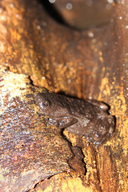|
Uperodon nagaoi (Manamendra-Arachchi & Pethiyagoda, 2001)
Nagao's Globular Frog | family: Microhylidae subfamily: Microhylinae genus: Uperodon |
| Species Description: Manamendra-Arachchi and Pethiyagoda. 2001. Journal of South Asian Natural History 5:122. | |
 © 2011 Champika Sandaruwan Holiya Bandara (1 of 5) |
|
|
|
Description Colour in life: body both dorsally and ventrally is dark brown. Infraorbital, postorbital and upper lip with yellow spots. Reddish-orange patches present on snout, sides of dorsum, abdomen, around vent and on limbs. Distinct reddish orange cross-bars on proximal end of tibia and tibiotarsal articulation. Juveniles darker than adults (Manamendra-Arachchi and Pethiyagoda, 2001). Colour in alcohol: body dark brown. Irregular dark brown patches on dorsum. Belly dark brown or ashy-dark brown with few light ashy patches. Some specimens have light brownish markings around the vent, tibiotarsal articulation and tarsi. Finger and toe tips, subarticular tubercles, palmar tubercles and metatarsal tubercles light ash (Manamendra-Arachchi and Pethiyagoda, 2001). Distribution and Habitat Country distribution from AmphibiaWeb's database: Sri Lanka
Life History, Abundance, Activity, and Special Behaviors Comments Etymology: Uperodon nagaoi is named after Mr. Eijiro Nagao, President of Marusan Securities Co. Ltd. Of Japan, who is thanked for the Nagao Environmental Foundation's generous support of research into the amphibians of Sri Lanka (Manamendra-Arachchi and Pethiyagoda, 2001). Uperodon nagaoi is found exclusively in tree-holes either alone or in mutualism relationship with at least two species of Poecilotheria sp. (Tarantula/ Tiger spiders) (Karunarathna and Amarasinghe, 2009). Genetically, U. nagaoi is closely related to U. obscurus and U. palmatus; from these it was found to differ by an average uncorrected genetic distance of 5.6% (N = 6) and 4.0% (range 4.0–4.2%, N = 8), respectively (Garg et al.,2018; Wijayathilaka et al 2018).
References
Batuwita S, Udugampala S, DeSilva M, Diao J and Edirisinghe U. (2019). "A review of amphibian fauna of Sri Lanka: distribution, recent taxonomic changes and conservation." Journal of Animal Diversity, 1(2), 44-82. [link] Garg S., Senevirathne G., Wijayathilaka N., Phuge S., Deuti K., Manamendra-arachchi K., Meegaskumbura M. and Biju S.D. (2018). "An integrative taxonomic review of the South Asian microhylidgenus Uperodon." Zootaxa, 4384(1), 1-88. [link] Karunarathna D. M. S. S. and Amarasinghe A. A. T. (2009). "Mutualism in Ramanella nagaoi Manamendra-Arachchi & Pethiyagoda, 2001 (AMPHIBIA: MICROHYLIDAE) and Poecilotheria species (ARACNIDA: THEREPOSIDAE) from Sri Lanka." Tapbrobanica, 1(1), 16-18. Manamendra-Arachchi K. and Pethiyagoda R. (2001). "Ramanella nagaoi, a new tree-hole frog (Microhylidae) from southern Sri Lanka." Journal of South Asian Natural History, 5(2), 121-133. Wijayathilaka N, Senevirathne G., Bandara C., Rajapakse S., Pethiyagoda R., Meegaskumbura M. (2018). "Integrating bioacoustics, DNA barcoding and niche modeling for frog conservation -- the threatened balloon frogs of Sri Lanka." Global Ecology and Conservation, 16, 2351-9894. [link] Originally submitted by: Dayupathi Eranda Nipunika Mandawala (2021-03-12) Description by: Dayupathi Eranda Nipunika Mandawala (updated 2021-03-12)
Distribution by: Dayupathi Eranda Nipunika Mandawala (updated 2021-03-12)
Life history by: Dayupathi Eranda Nipunika Mandawala (updated 2021-03-12)
Comments by: Dayupathi Eranda Nipunika Mandawala (updated 2021-03-12)
Edited by: Michelle S. Koo (2021-03-12) Species Account Citation: AmphibiaWeb 2021 Uperodon nagaoi: Nagao's Globular Frog <https://amphibiaweb.org/species/6397> University of California, Berkeley, CA, USA. Accessed Jun 13, 2025.
Feedback or comments about this page.
Citation: AmphibiaWeb. 2025. <https://amphibiaweb.org> University of California, Berkeley, CA, USA. Accessed 13 Jun 2025. AmphibiaWeb's policy on data use. |



 Map of Life
Map of Life